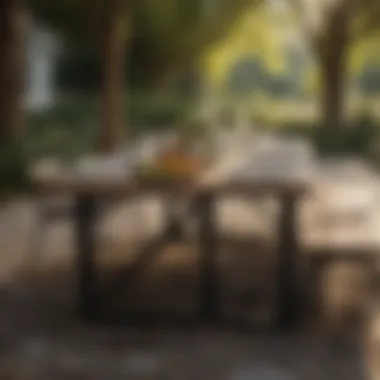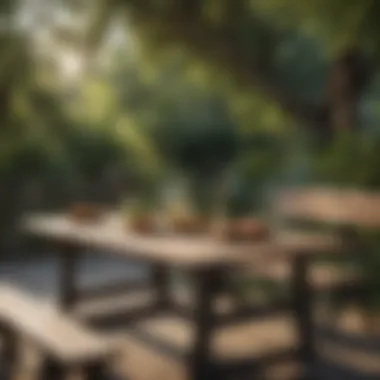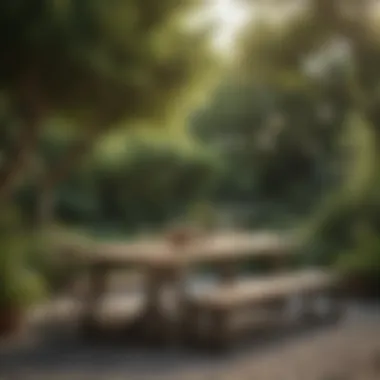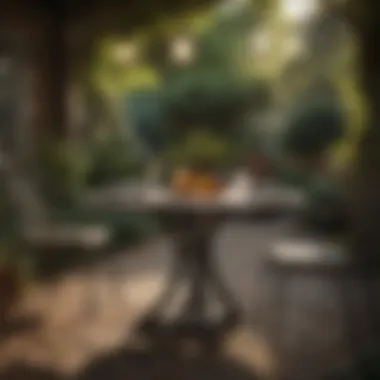Choosing the Perfect Outdoor Table for Your Space


Intro
Choosing the right outdoor table can significantly shape your outdoor environment. An optimal table not only enhances aesthetic appeal but also serves functional purposes as a gathering space for family and friends. This guide aims to clarify the essential elements to consider when selecting an outdoor table. We will break down materials, design choices, sizes, and practical usability.
In today’s society, outdoor living spaces have become an extension of our homes. Many individuals seek to create areas that reflect their personal style while being comfortable and practical. Understanding the trends and focusing on functionality can help guide your decision-making process. More than simply a piece of furniture, an outdoor table is a centerpiece for social interactions or quiet contemplation in your yard or patio.
Key Insights and Trends
Current Trends in Outdoor Furniture Design
Outdoor furniture trends evolve, reflecting broader changes in lifestyle and aesthetic preferences. Currently, eco-friendly materials such as reclaimed wood and bamboo are gaining traction. these materials often provide durability and a rustic flair. Additionally, minimalist designs featuring sleek lines and geometric shapes are popular. They often suit various outdoor settings, from coastal retreats to urban balconies.
Popular Gardening Techniques of the Season
When selecting a table, consider how it fits into your wider outdoor environment, including garden styles. Raised garden beds are in vogue, allowing homeowners to grow their herbs and vegetables easily. Vertical gardening is also popular in smaller spaces, making efficient use of available area. An outdoor table should complement these gardening techniques, offering a cohesive look and functional surface for potting or displaying your plants.
"Your outdoor table can enhance not just the visual appeal but also the overall utility of your outdoor space."
Practical Tips and How-To Guides
Step-by-Step Guides for Choosing an Outdoor Table
- Assess Your Space: Measure the areas in which you intend to place the table. Ensure you account for movement space.
- Determine Usage: Define if the table will be for casual meals, formal dining, or multiple functions. This impacts the size and height you need.
- Select Material: Choose from options like metal, wood, or plastic. Each one has its pros and cons concerning durability and maintenance.
- Choose Design: Find a design that resonates with your personal style. Look for balance with existing outdoor elements, such as seating and decor.
- Consider Weather Resistance: Select a table designed for your local climate if it will be exposed to elements year-round.
- Style and Finish: Don’t neglect colors and finishes. These can alter the perception of space significantly.
Entertaining Tips and Planning Checklists
When hosting gatherings, consider how your outdoor table fits into the plans:
- Create Comfort: Ensure there are enough seats, cushions, and shade arrangements.
- Lighting: Consider options like string lights or lanterns to create a welcoming atmosphere.
- Accessories: Use tablecloths, centerpieces, and dinnerware that complement the table’s material and design.
- Seasonal Decor: Changing decorations according to seasons can keep your outdoor area fresh and engaging.
Understanding the Importance of Outdoor Furniture
Selecting the right outdoor furniture is pivotal for homeowners aiming to maximize their outdoor environments. Outdoor furniture, particularly tables, serves both functional and aesthetic purposes. A well-chosen outdoor table can enhance usability and create inviting areas for gatherings and family meals.
Defining Outdoor Space Usage
The usage of an outdoor space significantly influences the type and style of table selected. First, one must consider how the space is intended to be used. Do you plan frequent family meals outdoors, host gatherings with friends, or perhaps use the area simply for relaxation? Each scenario dictates different requirements.
- Family meals may require a sturdy and spacious table to accommodate multiple diners.
- Casual gatherings might benefit from a more versatile table that can be easily moved or rearranged.
- For relaxation, a small, decorative table could be adequate for holding drinks or snacks.
Understanding these elements shapes the decision-making process. Assessing your outdoor activities ensures that you choose a table that aligns with your lifestyle needs while maximizing the potential of your space.
Impact on Aesthetics and Usability
The aesthetic qualities of outdoor furniture can dramatically influence the overall appeal of external areas. First impressions count, and an attractive outdoor table can elevate the visual aspect of patios, gardens, or balconies. Design, material, and color coordinates with the existing space can enhance the environment significantly.
A functional design is equally important. A table should not only complement your outdoor décor but also serve its intended purpose efficiently. For instance:


- Material choice plays a major role in usability. Tables made of weather-resistant materials can endure the elements while maintaining functionality.
- Color and style can enhance mood and vibe. Bright colors may evoke a lively atmosphere, whereas neutral tones tend to create a more relaxing setting.
"A well-furnished outdoor space is an extension of your home, providing both aesthetic pleasure and practical utility."
Thus, understanding the intersection between aesthetics and usability is critical when selecting the right outdoor table. This ensures your selection contributes positively to your outdoor living experience.
Criteria for Selecting an Outdoor Table
Selecting an outdoor table can significantly influence the functionality and aesthetic appeal of your outdoor space. This decision encompasses multiple considerations, from materials to design choices. Ideally, the right table fits harmoniously into the environment you create outside your home.
Material Considerations
Choosing the appropriate material is crucial because it directly impacts durability and maintenance of the outdoor table.
Wood
Wood is often favored for its natural beauty and warmth. It can seamlessly integrate into various outdoor settings. A major characteristic of wood is its sturdy yet lightweight nature, making it easy to manipulate while retaining its structural integrity. However, wood requires regular treatment to resist environmental elements, making its maintenance a significant consideration. Some popular wood choices include teak, cedar, and eucalyptus, each offering unique aesthetics and durability levels.
Metal
Metal tables, such as those constructed from aluminum or wrought iron, are known for their longevity and resilience. The key characteristic of metal is its ability to withstand harsh weather conditions. They tend to be heavier, providing stability against winds. Metal tables are also typically easier to clean. However, they may become hot in the sun and can develop rust if not properly treated, which could be a disadvantage depending on the climate where you live.
Plastic
Plastic outdoor tables present a lightweight and cost-effective option. One of the primary benefits of plastic is its resistance to fading, rotting, and general wear. These tables are available in a variety of colors and styles that can mimic the look of more expensive materials. However, they may not have the same durability as wood or metal, especially with prolonged exposure to sun or extreme temperatures, leading to potential fading or cracking over time.
Composite
Composite materials are synthetic blends, often combining wood fibers and plastic. This material choice offers an interesting blend of characteristics, combining the aesthetic appeal of wood with the durability of plastic. Composite tables tend to be resistant to moisture and insects. The downside can be their weight and sometimes higher cost compared to traditional materials.
Size and Dimensions
Understanding the dimensions of your outdoor area is key to selecting the right table. The size of the table will directly affect how feasible it is to occupy the space comfortably.
Understanding Available Space
Determining the space available is fundamental. The key characteristic to remember is that a table should allow enough room for chairs and movement around it. It's wise to measure the area prior to selection. A compact table may fit snugly into a small space, while a larger table can become a focal point in an expansive environment. If space is limited, consider options that allow some folding capability.
Table Shape Options
The shape of the table can alter the usability of the area. Round tables, for instance, can encourage conversation and fit better into tighter spaces, while rectangular tables typically provide a more formal appearance and can accommodate more people. Square tables occupy less space but may restrict seating arrangements. Pick a shape that fits your space and intended use effectively.
Design and Aesthetic Choices
The design and aesthetic choices of an outdoor table should reflect your personal style and the overall outdoor condition.
Modern vs. Traditional Styles


Styles range widely from modern, sleek lines to traditional, ornate designs. A key characteristic of modern styles involves minimalistic and functional designs that often feature bold colors and materials. In contrast, traditional styles include intricate detailing and classic shapes. Understanding your aesthetic preference can help narrow down choices and ensure that the table complements existing outdoor features.
Color Coordination
The color of an outdoor table plays a significant role in overall design cohesion. Color coordination can either enhance or distract from the outdoor scenery. Neutral colors often provide versatility, while bold colors can serve as statement pieces. Consider existing landscaping elements, as well as personal preferences, when selecting the color of your table.
"The right outdoor table not only enhances usability but also elevates the overall aesthetic of the space."
By carefully assessing these criteria when selecting your outdoor table, you can make an informed decision that contributes positively to your outdoor living area.
Top Outdoor Tables to Consider
When looking for an outdoor table, the choices available can be overwhelming, yet essential. Tables serve as a centerpiece for any outdoor area, influencing both the functionality and aesthetic of the space. Selecting the right table will not only ensure usability but will also enhance the overall ambiance.
Table One: Detailed Overview
Material and Build Quality
The material of an outdoor table is of utmost importance. It impacts durability, maintenance, and how well the table withstands the elements. One popular choice is teak wood, known for its resistance to rot and insect damage. This quality stems from its high oil content, which also gives it a beautiful natural finish. However, teak can be expensive, which is a potential drawback. For a more budget-friendly option, aluminum tables are also popular. They are lightweight and resistant to rust. But, unlike wood, aluminum might not provide the same warmth in the garden environment.
Design Features
The design features of a table affect how it fits within your space and its appeal. For example, many prefer tables with extendable features. This is especially useful for gatherings, allowing for easy accommodation of extra guests. Alternatively, tables with built-in umbrella holes provide shade during sunny days. The downside might be that these features can complicate the design, making some tables difficult to pair with specific decor styles.
Dimensions
Getting the dimensions right is critical. Tables come in various sizes, so matching the table to the available space is key. A good measure is to leave at least 30 inches between the table and any surrounding structures. For smaller spaces, considering a round table may work better, as it often encourages conversation and can fit snugly into corners. The limitation lies in the possible restriction on seating compared to rectangular tables.
Table Two: Detailed Overview
Material and Build Quality
For another option, fiberglass tables are emerging as robust contenders. Fiberglass is not only lightweight, but it is also highly weather-resistant. This choice makes it a favorite for regions with extreme weather conditions. However, fiberglass may scratch more easily than some metals or woods, which can be a concern for long-term use.
Design Features
Considering the design features of fiberglass tables, many come with smooth surfaces that are easy to clean. Some are also available in various colors, which can align well with a home’s exterior color scheme. However, customization options can be limited so, it is important to find a table that matches your preferred aesthetic from the outset.
Dimensions
When it comes to dimensions, fiberglass tables typically offer a range of sizes. It's common to find options that are specifically designed for smaller patios, making them ideal for urban living. Pay attention to the table's height too, as dining tables should be around 28 to 30 inches tall for comfort. Yet, they can be less suitable for outdoor spaces where lower seating, like benches, are present.
Choosing the right outdoor table involves balancing material compatibility, design appeal, and space requirements to create a functional and inviting atmosphere.
Usage Scenarios for Outdoor Tables
Understanding the various usage scenarios for outdoor tables is crucial for making an informed purchase. Different situations require different table styles, sizes, and features. Arms yourself with knowledge about how you plan to use your outdoor table. This aspect can dramatically influence your choice, ensuring that you select a table that meets the practical requirements while also blending seamlessly with your outdoor space.


Casual Gatherings and Family Meals
Casual gatherings and family meals are likely the most common uses for outdoor tables. These occasions call for tables that promote comfort and connection. A larger table can accommodate family dinners or barbeques with friends. The material should be durable yet easy to clean, as spills are common.
When selecting a table for these scenarios, consider the seating arrangement. Lightweight tables made of aluminum or treated wood can be easy to rearrange as guests come and go. Comfort becomes key; padded chairs can enhance the experience during longer meals.
Formal Entertaining and Dinner Parties
In contrast, formal entertaining involves different expectations. Here, aesthetic appeal takes precedence. Opt for tables with attractive finishes that complement your outdoor decor. Materials like teak or wrought iron convey a sense of elegance and can withstand the elements while providing a sophisticated look.
It’s also essential to think about the size. A traditional rectangular table can work well for larger gatherings, letting guests spread out while dining. Utilizing table settings that reflect the formality of the event, such as elegant flatware and linens, can also enhance the atmosphere.
Recreational Activities
Outdoor tables are not limited to dining purposes; they also serve as gathering points for recreational activities. Whether it’s a game of cards, a craft project, or a simple relaxed space for reading, the right outdoor table accommodates these needs.
Select a table that matches the activity. For crafts, consider a durable, waterproof surface that can withstand spills from paint or other supplies. Opt for a round table for card games, as it encourages easy interaction among players.
For all scenarios, remember that the placement of your outdoor table can greatly affect its usability. Ensure that it is situated in a well-lit area if used for activities in the evening.
Maintenance and Care for Outdoor Tables
Maintaining your outdoor table is crucial for preserving its appearance and functionality over time. An outdoor table can withstand various weather conditions, but neglect can lead to deterioration. Regular care not only prolongs the life of the table but also keeps it looking attractive. These tasks may seem trivial, but they significantly impact the overall aesthetics of your outdoor space. Investing time in maintenance ensures that your gathering areas remain inviting and presents a well-kept image of your home.
Cleaning Techniques
Effective cleaning techniques depend on the material of your outdoor table.
- Wood Tables: Use a soft brush or cloth to remove dust and debris. Clean with a mild soap and water solution, taking care to dry it afterward to prevent water damage. Consider applying a wood conditioner annually to maintain the finish.
- Metal Tables: Rinse with water to remove loose dirt. For more built-up grime, a mixture of mild soap and water works well. Avoid harsh chemicals as they can damage the finish.
- Plastic Tables: Often, a simple scrub with warm, soapy water is sufficient. For stains, a diluted vinegar solution can be effective.
- Composite Tables: These materials can usually withstand harsher cleaning agents. A pressure washer can be ideal, but use it at a safe distance to avoid damaging the surface.
Regular cleaning helps prevent staining and preserves the color and integrity of outdoor tables.
Seasonal Storage Tips
Storing an outdoor table during harsh weather is vital in prolonging its life. Whether it's snow, heavy rains, or intense sun, protection is key.
- Covering: Invest in high-quality outdoor table covers. They should fit snugly to protect against dust and debris.
- Indoor Storage: If possible, bring tables indoors during the off-season. A garage or basement can help shield them from extreme conditions.
- Elevating: If you cannot store your table completely, elevate it off the ground to prevent water pooling underneath.
- Maintenance Before Storage: Ensure that the table is clean before storing. For wood tables, apply a protective sealant to guard against moisture.
Each of these steps play a role in keeping your outdoor table in optimal condition. Following these guidelines will enhance both the beauty and usability of your outdoor space.
The End: Making an Informed Choice
Making an informed choice when selecting an outdoor table is crucial for optimizing your outdoor space. You want to ensure that the furniture you choose enhances usability, reflects your personal style, and stands the test of time. This decision is not just about aesthetics, but also about how well the table meets your specific needs.
Understanding the materials is fundamental. Different materials like wood, metal, and plastic each have unique benefits and drawbacks. For instance, wooden tables have a classic appeal but may require more maintenance. On the other hand, metal tables can offer durability but might not suit every climate. The choice of materials should align with your environment, intended use, and maintenance willingness.
Size and design are equally important elements. You must consider the space available and how the table fits within that context. A large table in a cramped area can overwhelm the space, while a too-small table may not be functional for gatherings. Take precise measurements of your area and think about how many people you typically host to determine the best size.
Additionally, look at design styles and color schemes. The table should harmonize with your existing decor and landscaping to create a cohesive look. A modern metal table may clash with a rustic garden, which can lead to a disjointed aesthetic. Choosing the right style ensures that your outdoor area is both inviting and functional.
Lastly, consider the practical aspects, such as maintenance requirements and usage scenarios. Understanding how the table will be used—whether for casual family meals, formal entertaining, or outdoor activities—will inform your choice. Tables designed for versatility will usually serve you better.
"Selecting the right outdoor table is like finding the perfect piece to complete a puzzle; it requires thought and consideration."
In summary, the decision to choose an outdoor table requires careful deliberation. Consider Material, Size, Design, and Usage. By addressing these elements, you will create an outdoor space that is pleasing, functional, and aesthetically harmonizing with your overall home environment.
The right outdoor table can significantly enhance your outdoor experience, making it both enjoyable and functional for many years to come.



